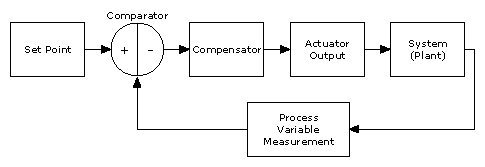Control Overview
In a typical control application, there are one or more process variables that you want to control, such as temperature. Sensors measure the process variable in the dynamic system and provide the data to the control application. The set point is the value you want for the process variable. A comparator determines if a difference exists between the process variable and the set point. If a difference exists and if the control system deems the difference large enough, the compensator processes the data and determines the desired actuator output to drive the system closer to the set point.

For example, in a temperature measurement system, if the actual temperature is 100 °C and the temperature set point is 120 °C, the compensator needs to take some action to raise the temperature. One actuator output might be to drive a heater at 62 percent of its maximum output capacity. The increased heater actuator output causes the system to become warmer, which results in an increased temperature. This kind of system is called a closed-loop control system because the process of reading sensors and calculating the actuator output you want repeats continuously at a fixed loop rate.
See Also